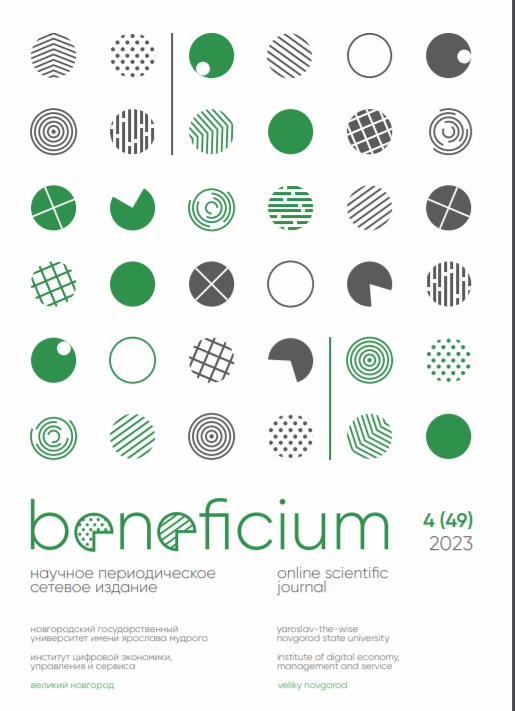USING INTERPOLATION FOR GENERATING INPUT DATA FOR THE GROSS DOMESTIC PRODUCT MONTE CARLO SIMULATION
Abstract
Input modelling is a complex task within the Monte Carlo simulation, especially when the systems and processes under investigation reveal the non-linear behavior of several interdependent variables. Commonly used approaches for Monte Carlo simulation input modelling include selecting probability distributions and fitting them to existing data; resampling random variates from historical data; and using real-world data as an input model, which in the age of big data becomes more feasible. Each of the approaches comes with its own set of drawbacks. This note aims to describe a new method of input modelling for GDP Monte Carlo simulation based on interpolation of the GDP historical records. Also, this method has been implemented as a publicly available online tool using the Microsoft Azure Machine Learning Studio. A similar approach can be applied to other macroeconomic indicators, e.g., consumer price index (inflation) or current employment statistics. This note is intended for economists, data scientists, and operations research analysts interested in the GDP Monte Carlo simulation. It can also be used by academics, researchers, and practitioners in a broad subject area for generating input data for Monte Carlo simulation. Specifically, it can be of interest for Ph.D. candidates (VAC specialty 5.2.6) performing development of theory and methods of decision-making in economic and social systems, and application of artificial intelligence and big data methods in management.
Keywords: Gross Domestic Product, input modelling; interpolation, machine learning, Monte Carlo method, simulation
References
Bean C.R. Independent review of UK economic statistics. Publisher: HM Treasury, 2016. 254 p.
Feldstein M. Underestimating the Real Growth of GDP, Personal Income, and Productivity // Journal of Economic Perspectives. 2017. Vol. 31(2). Pp. 145-164.
Jorgenson D.W. Production and Welfare: Progress in Economic Measurement // Journal of Economic Literature. 2018. Vol. 56(3). Pp. 867-919. DOI: 10.1257/jel.20171358
Rehman F., Cooper R.J. Effective GDP: A Cross‐Country Comparison // The World Economy. 2022. Vol. 46(3). Pp. 619-652. DOI: 10.1111/twec.13324
De Meo E., Tizzanini G. GDP-Network CoVaR: a Tool for Assessing Growth-at-Risk // Economic Notes. 2021. Vol. 50(2). DOI: 10.1111/ecno.12181
Wiedenhofer D., Virág D., Kalt G., Plank B., Streeck J., Pichler M., Mayer A., Krausmann F., Brockway P., Schaffartzik A. A systematic Review of the Evidence on Decoupling of GDP, Resource use and GHG Emissions, Part I: Bibliometric and conceptual Mapping // Environmental Research Letters. 2020. Vol. 15(6). Pp. 063002. DOI: 10.1088/1748-9326/ab8429
Charfeddine L., Klein T., Walther T. Reviewing the Oil Price–GDP growth Relationship: A replication Study // Energy Economics. 2020. Vol. 88. DOI: 10.1016/j.eneco.2020.104786
Maliszewska M., Mattoo A.A., Van der Mensbrugghe D. The potential Impact of COVID-19 on GDP and Trade: A Preliminary Assessment // Policy Research Working Paper. 2020. DOI: 10.1596/1813-9450-9211
Österholm P. The Long‐run Relationship Between Stock Prices and GDP in Sweden // Economic Notes. 2016. Vol. 45(2). Pp. 283-297. DOI: 10.1111/ecno.12057
Arnold U., Yildiz Ö. Economic risk analysis of decentralized renewable energy infrastructures–A Monte Carlo Simulation approach // Renewable Energy, Elsevier. 2015. Vol. 77(С). Pp. 227-239. DOI: 10.1016/j.renene.2014.11.059
Batkovskiy A.M., Konovalova A.V., Semenova E.G., Trofimets V.J., Fomina A.V. Study of economic systems using the simulation-based statistical modeling method // Mediterranean Journal of Social Sciences. 2015. Vol. 6(4). Pp. 369-380. DOI: 10.5901/mjss.2015.v6n4s4p369
Brandimarte P. Handbook in Monte Carlo simulation: applications in financial engineering, risk management, and economics. John Wiley & Sons Limited, 2014. 688 p.
Creal D.D survey of sequential Monte Carlo methods for economics and finance // Econometric Reviews. 2012. Vol. 31(3). Pp. 245-296. DOI: 10.1080/07474938.2011.607333
McLeish D.L. Monte Carlo simulation and finance. John Wiley & Sons Limited, 2011. 387 p.
Antonios A. An empirical analysis of simulated model of economic growth for United Kingdom // Journal of Statistical and Econometric Methods. 2019. Vol. 8(3). Pp. 1-19.
Gharehgozli O.A Monte Carlo Analysis of Robustness of the Synthetic Control Method and Dynamic Panel Estimation: A Comparative Case Study of a Policy Intervention // Journal of Statistical and Econometric Methods. 2020. Vol. 9(1). Pp. 67-87.
Lv J.P., Li Y.P., Sun J. Monte Carlo simulation based interval chance-constrained programming for regional ecosystem management – A case study of Zhuhai, China // Ecological indicators. 2018. Vol. 85. Pp. 214-228. DOI: 10.1016/j.ecolind.2017.10.027
Corlu C.G., Akcay A., Xie W. Stochastic Simulation under Input Uncertainty: A Review // Operations Research Perspectives. 2020. Vol. 7. Pp. 100162. DOI: 10.1016/j.orp.2020.100162
Botchkarev A. Assessing Excel VBA suitability for Monte Carlo simulation // Spreadsheets in Education. (EJSiE). 2015. Vol. 8(2). Pp. 4629. DOI: https://sie.scholasticahq.com/article/4629
Cheng R. History of input modeling // Winter Simulation Conference (WSC). 2017. Pp. 181-201. IEEE. DOI: 10.1109/WSC.2017.8247789
Cheng R.C., Currie C. S. Input modelling for multimodal data // Journal of the Operational Research Society. 2020. Vol. 71(6). Pp. 1038-1052. DOI: 10.1080/01605682.2019.1609887
Xie W., Nelson B.L., Barton R.R. Multivariate input uncertainty in output analysis for stochastic simulation // ACM Transactions on Modeling and Computer Simulation (TOMACS). 2016. Vol. 27(1). Pp. 1-22. DOI: 10.1145/2990190
Shuanglong S., Zhe Y., Shuaihua L., Da M., Yuheng X., Huan X., Chunyan W. Charging demand forecasting method based on historical data // IOP Conference Series: Earth and Environmental Science. 2019. Vol. 295(3). Pp. 032002. DOI: 10.1088/1755-1315/295/3/032002
Jeon S., Hong B. Monte Carlo simulation-based traffic speed forecasting using historical big data // Future generation computer systems. 2016. Vol. 65. Pp. 182-195. DOI: 10.1016/j.future.2015.11.022
Lepot M., Aubin J.B., Clemens F.H. Interpolation in time series: An introductive overview of existing methods, their performance criteria and uncertainty assessment // Water. 2017. Vol. 9(10). Pp. 796. DOI: 10.3390/w9100796
Jia Y., Ma J. What can machine learning do for seismic data processing? An interpolation application // Geophysics. 2017. Vol. 82(3). Pp. V163-V177. DOI: 10.1190/GEO2016-0300.1
Reinhardt K., Samimi C. Comparison of different wind data interpolation methods for a region with complex terrain in Central Asia // Climate Dynamics. 2018. Vol. 51(9-10). Pp. 3635-3652. DOI: 10.1007/s00382-018-4101-y
Appelhans T., Mwangomo E., Hardy D.R., Hemp A., Nauss T. Evaluating machine learning approaches for the interpolation of monthly air temperature at Mt. Kilimanjaro, Tanzania // Spatial Statistics. 2015. Vol. 14(A). Pp. 91-113. DOI: 10.1016/j.spasta.2015.05.008
Bélisle E., Huang Z., Le Digabel S., Gheribi A.E. Evaluation of machine learning interpolation techniques for prediction of physical properties // Computational Materials Science. 2015. Vol. 98. Pp. 170-177. DOI: 10.1016/j.commatsci.2014.10.032
Gerber M. S. Predicting crime using Twitter and kernel density estimation // Decision Support Systems. 2014. Vol. 61(1). Pp. 115-125. DOI: 10.1016/j.dss.2014.02.003
Crowley P.M., Hallett A.H. Correlations between macroeconomic cycles in the US and UK: What can a frequency domain analysis tell us? // Italian Economic Journal. 2016. Vol. 2(1). Pp. 5-29. DOI: 10.1007/s40797-015-0023-6
Qin D., Cagas M.A., Quising P., He X.H. How much does investment drive economic growth in China? // Journal of Policy Modeling. 2006. Vol. 28(7). Pp. 751-774. DOI: 10.1016/j.jpolmod.2006.02.004
Interpolation (2021). Wikipedia. URL: https://en.wikipedia.org/wiki/interpolation (accessed on 03.02.2021).
Heijungs R. On the number of Monte Carlo runs in comparative probabilistic LCA // The International Journal of Life Cycle Assessment. 2020. Vol. 25(2). Pp. 394-402. DOI: 10.1007/s11367-019-01698-4
Oberle W. Monte Carlo simulations: number of iterations and accuracy. Army Research Lab Aberdeen Proving Ground Md Weapons and Materials Research Directorate, 2015. 26 p.
Botchkarev A. Data Analysis and Interpolation Using R (2018). Experiment in Microsoft Azure Machine Learning Studio. Azure AI Gallery. URL: https://gallery.azure.ai/Experiment/Data-Analysis-and-Interpolation-Using-R (accessed on 05.02.2021).
S. Bureau of Economic Analysis. GDP and Other Major NIPA Series, 1929–2012: II. Part of Survey of Current Business. 2012. Vol. 92(8). Pp. 183-212.
Zeileis A., Grothendieck G. zoo: S3 Infrastructure for Regular and Irregular Time Series // Journal of Statistical Software. 2005. Vol. 14(6). Pp. 1–27. https://doi.org/10.18637/jss.v014.i06
About the Author
Alexei M. Botchkarev – Cand. Sci. (Engineering); Senior Research Associate, Financial University under the Government of the Russian Federation, Moscow, Russia. E-mail: AMBotchkarev@fa.ru. SPIN РИНЦ 7103-4875. ORCID 0000-0002-0689-8830. ResearcherID G-1173-2011. Scopus Author ID 24823757400
For citation: Botchkarev A.M. Using Interpolation for Generating Input Data for the Gross Domestic Product Monte Carlo Simulation // BENEFICIUM. 2023. Vol. 4(49). Pp. 33-37. DOI: 10.34680/BENEFICIUM.2023.4(49).33-37









